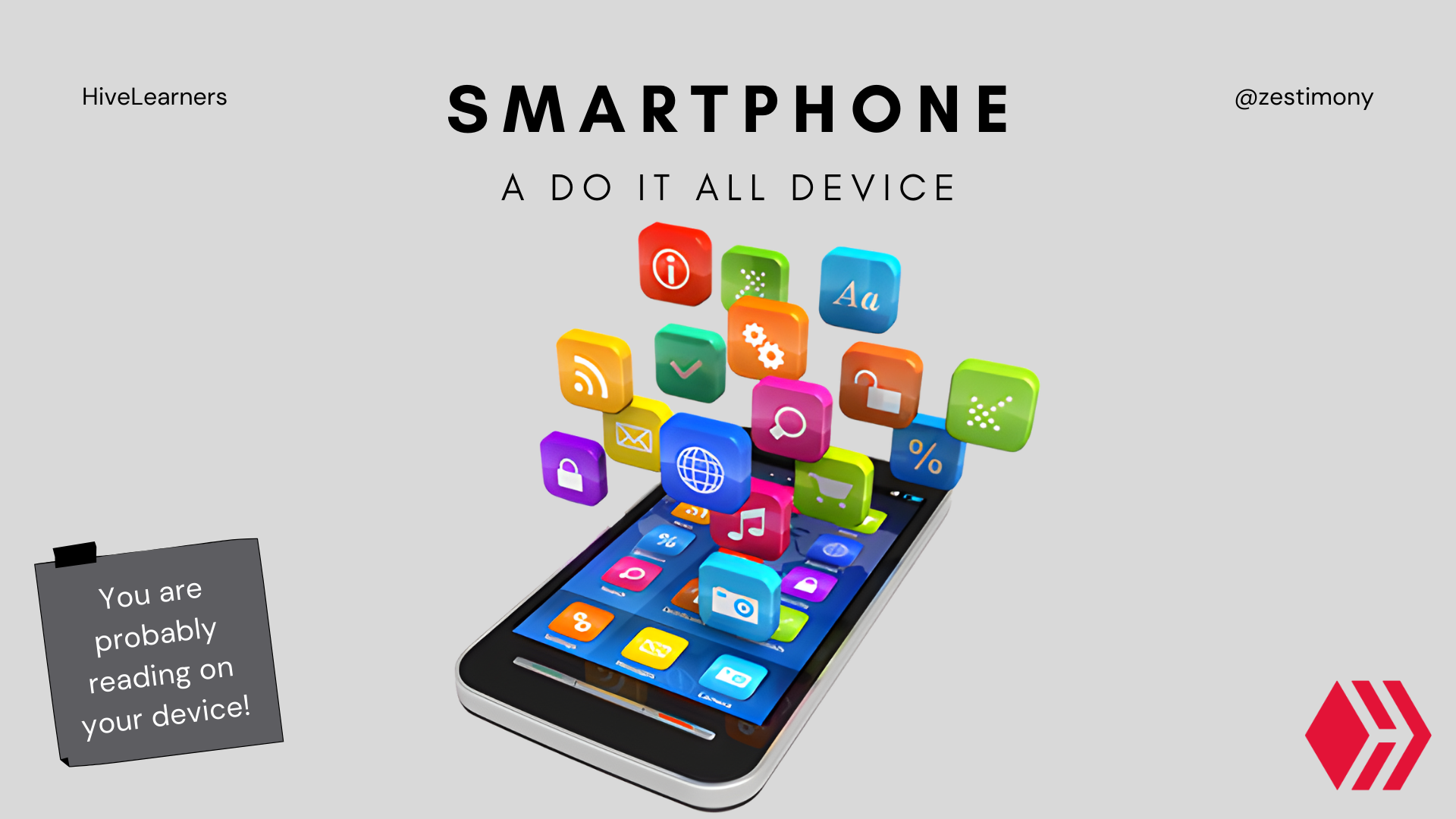An Unsung Innovation - The Smartphone
Smartphones are everywhere, and as a result, we could easily take them for granted. In this account of my favourite technological advancement, I want to reintroduce you to the:
¸,ø¤º°°º¤ø,¸¸,ø¤º° 🅢🅜🅐🅡🅣🅟🅗🅞🅝🅔 °º¤ø,¸¸,ø¤º°°º¤ø,¸
°º¤ø,¸¸,ø¤º° 🅢🅜🅐🅡🅣🅟🅗🅞🅝🅔 °º¤ø,¸¸,ø¤º°°º¤ø,¸ 
To begin, let me reiterate the words of Steve Jobs on the day of the first iPhone launch event. Here is how he introduced the iPhone:
An iPod, a phone, and an Internet communicator... It is called, iPhone
Steve Jobs, 2007
The iPhone was touted as a do-it-all device by the words of this introduction. The iPhone was not the first smartphone, but it laid the groundwork for smartphones as we know it today.
Away from the iPhone, for me, smartphones in general are one of the key exciting technological innovations of our time that I'm most excited about.
What's a Smartphone?
A smartphone is simply an almost all-in-one portable computer. According to a Wikipedia article, a smartphone is:
A portable device that combines mobile telephone and computing functions into one unit.
While the above description is correct, to me, it does not painting the full picture of what a smartphone is.
To me, a smartphone is a portable communication device with computing functions and could be, and is not limited to, a camera, a camcorder, a gaming console, a barcode/QR code scanner, and effectively be whatever it's user deems it to be.
Our smartphones have become so powerful that they can easily substitute the role of most electronic devices. Most of the time, the limit is on the technical-know-how of the user.
- For business people and individuals working in an organization, the smartphone can be their calculator, their organizer, their time-keeping machine, and much more.
- For creatives, a smartphone is their camera, their camcorder, their video and photo editing machine, their portal to the world, and much more.
- For engineers, a smartphone can be their 3D scanner, their measurement device, their scientific calculator, and much more.
- For regular people with no specific needs, a smartphone could be their music player, their cinema, their e-reader, their portal to the world, and much more.
The basic fact is that the smartphone can be all things to all people.
You, I mean you, yes you yourself, can attest to this fact!
The Evolution of Smartphones
Smartphones have continued to evolved from strength to strength since the modern era was ushered in by the first iPhones and Android phones in the world.
If you have followed the smartphone trend for some time now, you may have noticed that smartphones while initially very basic and tiny, are now humongous and very powerful devices.
Here are some key and exciting evolutions in overtime:
Screen size
Smartphones have grown from a mostly screen sizes around 3.5inch to almost 7-inch diagonally. This is unsurprising as the smartphone display remains the portal to the device.
To accommodate the large screen sizes, phones has moved from having bezels around their displays to having bezel-less displays.
Memory and Processing Power

Smartphones have not just grown bigger in size, today most smartphones can perform tasks our average computer struggles with. You can test this swiftly by recording 4K footage on your phone, copy it to your PC and try to play it. Our phones have also grown from 512 MB of RAM to as much as 18gb of RAM. Storage has also grown, from basic 4gb's to some phones having a 1 terabyte option. All these, just within a period of 20 years.
Camera
This is one of the most highlighted aspects of the smartphone evolution. In fact, most smartphone launch events spend over 50% of the keynotes on camera improvements, the night modes (AKA nightography), video improvements, Apple's deep fusion technology, Portrait mode for videos and images, Zoom lenses (AKA, telescope cameras), and much more. 
Currently, if a digital content, be it video or an image was made on a smartphone, we may have a hard time telling it apart from that made using professional and highly expensive devices. This is especially so when you have the smartphone in the hands of the right person, a highly skilled person.
Battery life
Our phones started out with very meager battery life, most of which were below 2,300mAH, barely capable of lasting a full day of use. However, currently, we have phones with high battery capacity, the common among which is 4,000-5000mAH, though some smartphones can even boast of more.

Our smartphone batteries are now so good, they can even be used to charge other devices (you can ask SAMSUNG about reverse wireless charging). Most of these devices can run comfortably for two full days. Another exciting battery-related innovation is charging speed. Most phones can go from 0-100% battery in less than 30 minutes.
Applications
At the heart of our smartphones are applications (apps). In fact, our smartphones are nothing without them. Applications are what make our phones smart. Applications naturally extend the functionality of our smartphones beyond their normal reach. You can get an app for almost everything you could think of.

As results of apps, smartphones can now be used in religious settings, academics/education, workplaces, business places, and much more.
The Skyrocketing Smartphone prices and My Thoughts on It
As phones innovated, so did their prices. Smartphones initially did not cross the 500 USD price mark for many years, but with the iPhone 10 (x), Apple showed the world that smartphones could be more expensive with a 1000 USD price tag. Manufacturers were quick to adopt this.
Currently, you can get a Samsung foldable phone for as much as $2,000+. These prices are worth it to me based on the innovative features packed into these devices. Smartphones are highly complex and packing so much into such a small form factor while retaining efficiency and efficacy is a huge feat to achieve. Kudos to them!
Imagine trying to purchase all the things a smartphone replaces individually: a computer, a gaming console, a DSLR camera, a calculator, a notepad, a voice recorder, etc. You see, the price can easily add up.
Additionally, a lot of work goes into these devices, years of research and development, and years of support. So, their prices can easily be justified.
On the flipside!
Unless you can really justify your need for a very expensive smartphone, I do not think they are really worth it. Smartphones could be classified into three common categories:
- The low-end smartphones, which are usually very cheap, slow, and made of very cheap materials, with bad camera and screen quality. These smartphones are okay for someone who does not rely so much on their smartphones, maybe our aging parents.
- Midrange smartphones are smartphones that most of us should look out for. They have okay specifications and C-to-B+ grade cameras, and are nice for almost everyone without any specific needs.
- The chief and highest category, known as the flagships are very expensive and are usually the best in class. These categories of phones are nice to have, but are best if one can afford them easily and when a person has a specific use-case for them.
Final Words
Smartphones are really exciting, and they have found a very unique place in our lives. Most of us can hardly survive a day without these devices. Our fun, our business, and even our memories are buried inside these smart devices. So, as much as you secure your wallet, I recommend you secure your phone just as much. I can, with a full chest, say that most of us can easily deal with the loss of a wallet but not the loss of our smartphones.
However, while the use of these devices has some obvious downsides which you should be aware of, no doubt, these devices have changed the world as we know it, and in the foreseeable future, we will keep relying on them as much as a child relies on his/her mum.









Comments